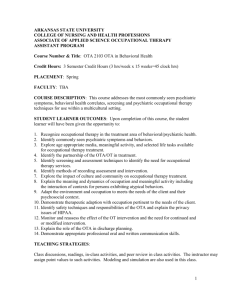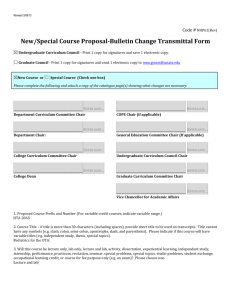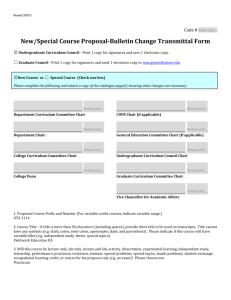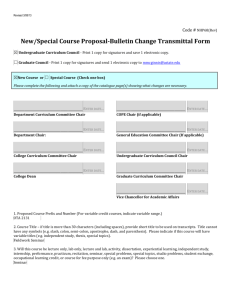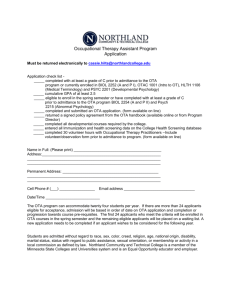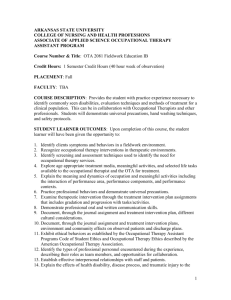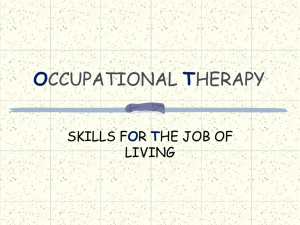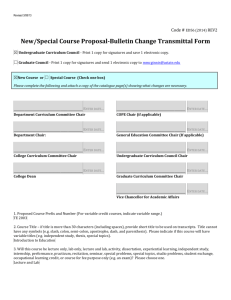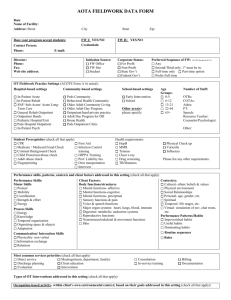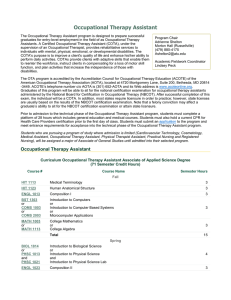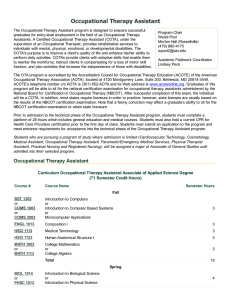New/Special Course Proposal-Bulletin Change Transmittal Form
advertisement
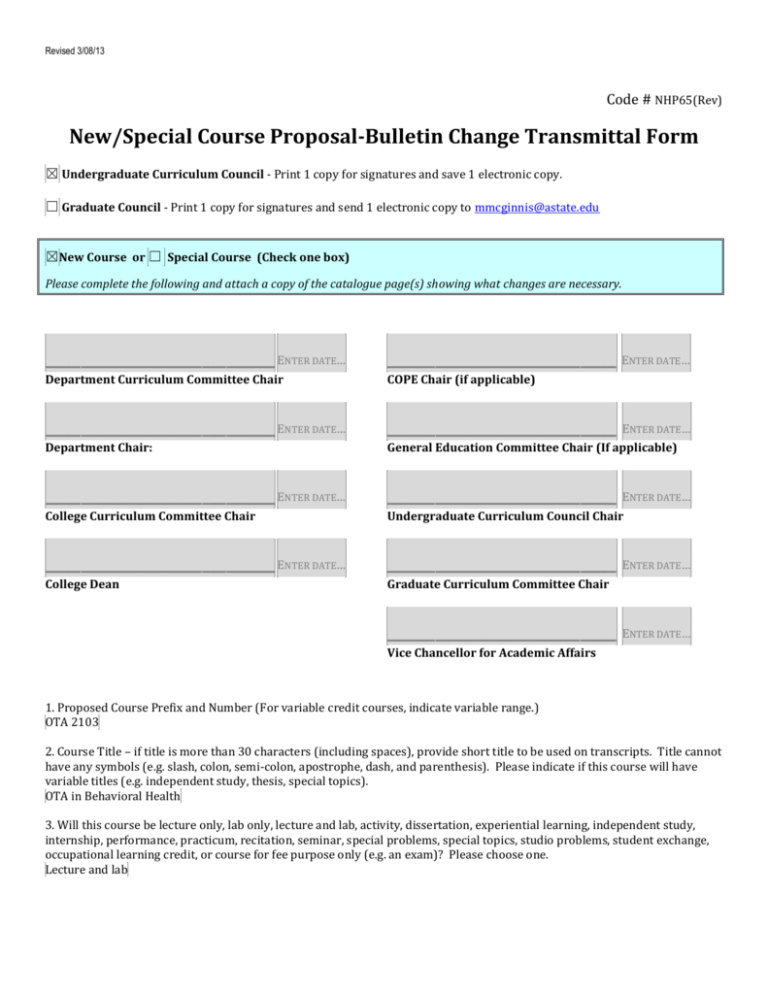
Revised 3/08/13 Code # NHP65(Rev) New/Special Course Proposal-Bulletin Change Transmittal Form ☒ Undergraduate Curriculum Council - Print 1 copy for signatures and save 1 electronic copy. ☐ Graduate Council - Print 1 copy for signatures and send 1 electronic copy to mmcginnis@astate.edu ☒New Course or ☐ Special Course (Check one box) Please complete the following and attach a copy of the catalogue page(s) showing what changes are necessary. ___________________ ENTER DATE… ___________________ ENTER DATE… ___________________ ENTER DATE… ___________________ ENTER DATE… Department Curriculum Committee Chair Department Chair: ENTER DATE… ___________________ ENTER DATE… ___________________ ENTER DATE… ___________________ ENTER DATE… COPE Chair (if applicable) General Education Committee Chair (If applicable) College Curriculum Committee Chair College Dean ___________________ Undergraduate Curriculum Council Chair Graduate Curriculum Committee Chair ___________________ ENTER DATE… Vice Chancellor for Academic Affairs 1. Proposed Course Prefix and Number (For variable credit courses, indicate variable range.) OTA 2103 2. Course Title – if title is more than 30 characters (including spaces), provide short title to be used on transcripts. Title cannot have any symbols (e.g. slash, colon, semi-colon, apostrophe, dash, and parenthesis). Please indicate if this course will have variable titles (e.g. independent study, thesis, special topics). OTA in Behavioral Health 3. Will this course be lecture only, lab only, lecture and lab, activity, dissertation, experiential learning, independent study, internship, performance, practicum, recitation, seminar, special problems, special topics, studio problems, student exchange, occupational learning credit, or course for fee purpose only (e.g. an exam)? Please choose one. Lecture and lab Revised 3/08/13 4. What is the grade type (i.e. standard letter, credit/no credit, pass/fail, no grade, developmental)? Standard letter 5. Is this course dual listed (undergraduate/graduate)? No 6. Is this course cross listed? (If it is, all course entries must be identical including course descriptions. It is important to check the course description of an existing course when adding a new cross listed course.) No 7. Brief course description (40 words or fewer) as it should appear in the bulletin. This course addresses the most commonly seen psychiatric symptoms, behavioral health correlates, screening and psychiatric occupational therapy techniques for use within a multicultural setting. 8. Indicate all prerequisites and if this course is restricted to a specific major, which major. (If a student does not have the prerequisites or does not have the appropriate major, the student will not be allowed to register). a. Are there any prerequisites? Admission to OTA program b. Why? Selective OTA program admission. 9. Course frequency (e.g. Fall, Spring, Summer). Not applicable to Graduate courses. Spring 10. Contact Person (Name, Email Address, Phone Number) Susan Hanrahan, PhD, PT Arkansas State University – Jonesboro hanrahan@astate.edu 870-972-3112 11. Proposed Starting Term/Year Spring 12. Is this course in support of a new program? Yes If yes, what program? Occupational Therapy Assistant program (OTA) 13. Does this course replace a course being deleted? No If yes, what course? Enter text... Has this course number been used in the past? No Submit Course Deletion Proposal-Bulletin Change Transmittal Form. 14. Does this course affect another program? No If yes, provide contact information from the Dean, Department Head, and/or Program Director whose area this affects. Enter text... 15. Justification should include: a. Academic rationale and goals for the course (skills or level of knowledge students can be expected to attain) 1. Recognize occupational therapy in the treatment area of behavioral/psychiatric health. 2. Identify commonly seen psychiatric symptoms and behaviors. Revised 3/08/13 3. 4. 5. 6. 7. 8. 9. 10. 11. 12. 13. 14. Explore age appropriate media, meaningful activity, and selected life tasks available for occupational therapy treatment. Identify the partnership of the OTA/OT in treatment. Identify screening and assessment techniques to identify the need for occupational therapy services. Identify methods of recording assessment and intervention. Explore the impact of culture and community on occupational therapy treatment. Explain the meaning and dynamics of occupation and meaningful activity including the interaction of contexts for persons exhibiting atypical behaviors. Adapt the environment and occupation to meets the needs of the client and their psychosocial context. Demonstrate therapeutic adaption with occupation pertinent to the needs of the client. Identify safety techniques and responsibilities of the OTA and explain the privacy issues of HIPAA. Monitor and reassess the effect of the OT intervention and the need for continued and or modified intervention. Explain the role of the OTA in discharge planning. Demonstrate appropriate professional oral and written communication skills. b. How does the course fit with the mission established by the department for the curriculum? If course is mandated by an accrediting or certifying agency, include the directive. Curriculum developed per accreditation guidelines Accreditation Council for OT Education (ACOTE) Standard and Interpretive Guide (Effective July 31, 2013) c. Student population served. Students admitted to OTA program. d. Rationale for the level of the course (lower, upper, or graduate). Undergraduate entry level course as per accreditation guidelines. 16. Outline (The course outline should be topical by weeks and should be sufficient in detail to allow for judgment of the content of the course.) Week 1 Course outline and therapeutic use of self Week 2 History of psychiatry in the US and internationally Week 3 Mental Health/Illness Week 4 Therapeutic use of self-2 Week 5 Symptomology of mental disorders and behavioral states Week 6 Overview of the intervention process/midterm Week 7 Data gathering and evaluation and coordination with the OT Week 8 Intervention planning and coordination with the OT Week 9 Intervention planning and coordination with the OT Week 10 Safety and suicide and diseases of malaise (drug and alcohol addiction) Week 11 Medical Records Week 12 Effective use of groups in treatment 1 Week13 Effective use of groups in treatment 2 Week14 Effective use of groups in treatment 3 Week 15 Final exam 17. Course requirements (e.g. research papers, projects, interviews, tests, etc.) Class discussions, readings, in-class activities, and peer review in class activities. The instructor may assign point values to such activities. Modeling and simulation are also used in this class. 18. Special features (e.g. labs, exhibits, site visitations, etc.) Simulation 19. Department staffing and classroom/lab resources (Will this require additional faculty, supplies, etc.?) Supported by OTA faculty; No additional classroom space required Revised 3/08/13 20. What is the primary intended learning goal for students enrolled in this course? Identify OTA assessment techniques and methods of treatment in behavioral health. 21. Reading and writing requirements: a. Name of book, author, edition, company and year REQUIRED TEXTS: Cole, M. (September 2011). Group Dynamics in Occupational Therapy: The Theoretical Basis and Practice Application of Group Intervention. Fourth Edition. SLACK, Incorporated. Thorofare, NJ. Bonder, B. (February 2010). Psychopathology and Function. 4th edition. SLACK, Incorporated. Thorofare, NJ. Early, M.B. (February 2008). Mental Health Concepts and Techniques for the Occupational Therapy Assistant. Lippincott: New York. b. Number of pages of reading required per week: 20 c. Number of pages of writing required over the course of the semester: 3 22. High-Impact Activities (Check all that apply) ☒ Collaborative assignments ☐ Research with a faculty member ☐ Diversity/Global learning experience ☐ Service learning or community learning ☐ Study abroad ☐ Internship ☐ Capstone or senior culminating experience ☐ Other Explain: Enter text... 23. Considering the indicated primary goal (in Box #20), provide up to three outcomes that you expect of students after completion of this course. Outcome #1: (For example, what will students who meet this goal know or be able to do as a result of this course?) Adapt the environment and occupation to meet the behavioral health needs of the client. Learning Activity: (For example, what instructional processes do you plan to use to help students reach this outcome?) Design an adapted environment for a given client. Assessment Tool: (For example, what will students demonstrate, represent, or produce to provide evidence of their learning?) Grading rubric for safety competencies as it relates to behavioral health. (Repeat if needed for additional outcomes 2 and 3) Outcome #2: Enter text... Learning Activity: Enter text... Assessment Tool: Enter text... Revised 3/08/13 Outcome #3: Enter text... Learning Activity: Enter text... Assessment Tool: Enter text... 24. Please indicate the extent to which this course addresses university-level student learning outcomes: a. Global Awareness ☐ Minimally ☐ Indirectly ☒ Directly b. Thinking Critically ☐ Minimally ☐ Indirectly ☒ Directly c. Using Technology ☐ Minimally ☒ Indirectly ☐ Directly From the most current electronic version of the bulletin, copy all bulletin pages that this proposal affects and paste it to the end of this proposal. To copy from the bulletin: 1. 2. 3. 4. 5. 6. 7. 8. 9. 10. Minimize this form. Go to http://registrar.astate.edu/bulletin.htm and choose either undergraduate or graduate. This will take you to a list of the bulletins by year, please open the most current bulletin. Find the page(s) you wish to copy, click on the “select” button and highlight the pages you want to copy. Right-click on the highlighted area. Click on “copy”. Minimize the bulletin and maximize this page. Right-click immediately below this area and choose “paste”. For additions to the bulletin, please change font color and make the font size larger than the surrounding text. Make it noticeable. For deletions, strike through the text, change the font color, and enlarge the font size. Make it noticeable. OTA 2103 – OTA in Behavioral Health This course addresses the most commonly seen psychiatric symptoms, behavioral health correlates, screening and psychiatric occupational therapy techniques for use within a multicultural setting.
